How to climb the Butte-Montmartre, without getting tired
This post is also available in:
![]()
How to climb the Butte-Montmartre ? It is not very high (130 m). However, one goes from 70 m (Bottom of the Butte) to the highest point over a distance of about 500 m. This means that the streets are quite steep.
Personal cars – and private buses – are not allowed on its narrow streets.
If you want to visit the Butte Montmartre it is wise to know what means of transportation are available and where the starting points are.
There are only 4 ways to “climb” the Butte, in addition to walking of course.
You have all the necessary indications below.
How to climb the Butte-Montmartre : the sporty ascent by the stairs to the Sacré-Coeur
To be precise, the entrance of the stairs is 1 Place Valadon (which is in fact a street, not a square). It is located at the junction between the street Tardieu and the street Saint Pierre (called “Place Saint Pierre”!?). The “Place Valadon” turns into a staircase 30 m further on, which is called “rue Foyatier”! Who knows why?
The staircase which goes along the funicular (the Foyatier street) has more than two hundred and twenty steps. It allows to reach the Lamarck street on the right, the Parvis and the Sacré-Coeur Basilica are 50 m away. If during your ascent you did not take the time to admire the panorama it is now from the Parvis that you have the best view on Paris.
It is also possible to go up to the Sacré-Coeur by several stairs located in the Square Louise Michel, on the right of the funicular. But save yourself for the rest of your visit: there are also many other stairs on the Butte. You will certainly have the opportunity to use them during your visit. Some people suffer from climbing them, others have sung about them (“They are hard on the wretched…”). The list of these stairs is long. We have listed some of them below:
- Staircase Paul Albert, “Littérateur”
- Stairs of the painter Utrillo street
- Passage Cottin
- Staircase of the rue du Chevalier de la Barre : It opens in front of the garden of Turlure, close to the Sacré-Coeur. You have to come at night to look at its cobblestones that turn into a starry sky. It is Alekan, chief operator and the sculptor Patrick Rimoux, who reproduced with optical fibers, the constellations of January 1st and July 1st.
- Going down rue Lamarck, you come across the stairs of rue Becquerel.
- On the other side of rue Lamarck, a pétanque court that is always frequented and another staircase, rue de la Bonne: there was one of the fountains of Montmartre whose water was famous.
- A little further down, the stairs of the rue du Mont-Cenis. One of the longest of the Butte. It is more oriented to the north than to the east
The funicular, or how to climb the Butte-Montmartre the easy way up to the Sacré-Coeur
The current funicular is the third one after the renovations of 1935 and 1991. It joins the “Rue Foyatier” at the height of the upper station. Then you just have to take the street Lamarck on the right, the Parvis du Sacré-Coeur is at about 50 m. And it is from the Parvis that the view on Paris is the most beautiful.
The 1st funicular of Montmartre or how to climb the Butte-Montmartre … in 1900
The first funicular of Montmartre was put into service on July 12 or 13, 1900.
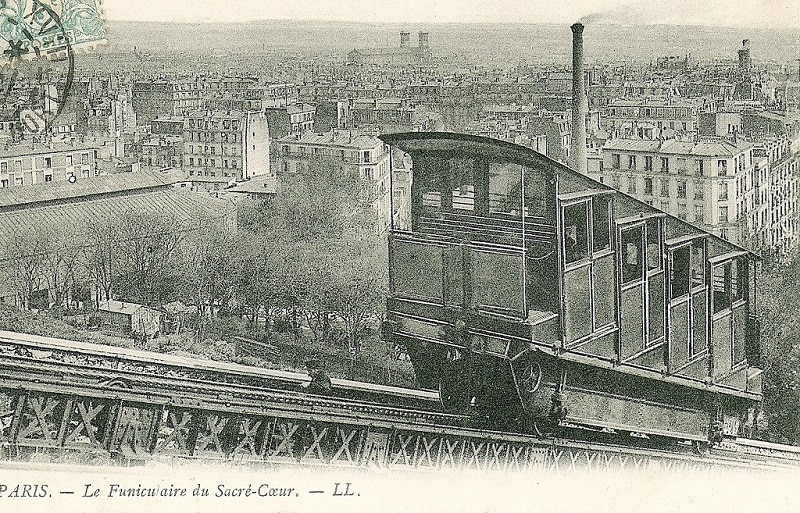
It includes 2 cabins built on 2 water tanks of 5 m3 and connected by a cable: the “high” tank of the cabin which is at the top, is folded of water. The “high” tank of the cabin which is at the top, is folded with water. Thus the cabin which is linked to it goes down by gravity by pulling up the 2nd empty tank cabin still at the bottom but which is linked to it by a cable and a pulley system. A steam engine located at the lower station activates the pumps that deliver the water to the upper station where the tanks are filled each time they pass.
The cabins have a capacity of forty-eight passengers divided into four closed compartments arranged in a staircase, the two end platforms being reserved for the driver (brakeman). They are held by a braking system established on the rack. This system carried a million passengers a year for about thirty years
1935 and the first renovation after good and loyal services of 35 years
The water funicular system was replaced by two electrically powered cabins and operations resumed on February 2, 1935 after a three-year interruption. The traction is ensured by a winch driven by a fifty horsepower electric motor, which allows the cabins with a capacity of fifty people to complete the journey in seventy seconds, that is to say a speed of two meters per second.
1991 : second renovation after 50 years of operation and millions of passagers
Having transported two million passengers every year, the funicular is in need of a major renovation.
Since this last renovation, the funicular uses the technology of an inclined elevator with electric traction. It is therefore no longer a funicular in the true sense of the word: it no longer operates according to the traditional reciprocating movement of funiculars and therefore allows for an increased transport capacity. The machinery has remained at the upper station. It consists of two completely independent winches driven by 130 kW motors. This means that one car can go up and the other down or be at a standstill, or both cars can go up or down together. This makes it possible to regulate the number of passengers.
The weight of a cabin is six tons when empty and ten tons when fully loaded. They have a service brake, a track brake and an emergency brake.
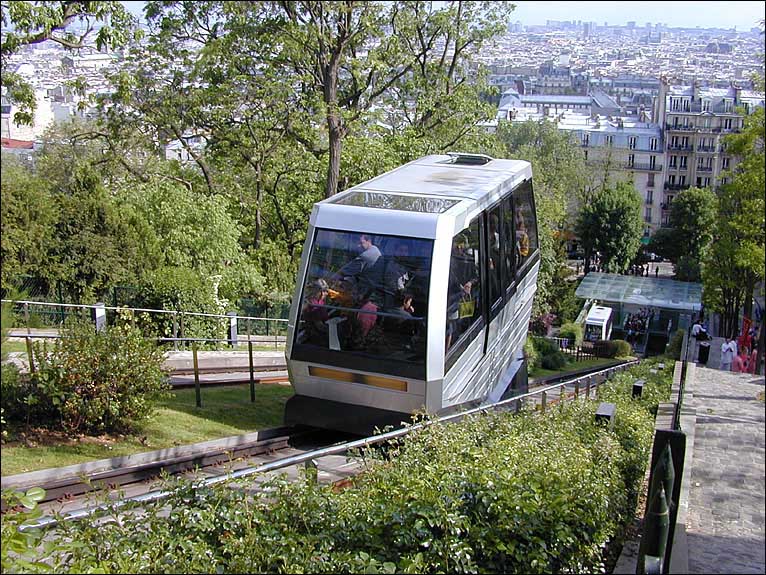
The operation is fully automated: the presence and number of passengers are detected by a system consisting of electronic scales located in the floor of the cabins and radars in the stations. A computer then determines the departure of the cabins, indicated to passengers by a display in the cabin. Depending on the density of the passenger flow, a choice is made between two possible speeds of 2 or 3.5 meters per second. Landing doors open only when the car is present to increase safety, similar to the metro line 14
However, on December 7, 2006, at 5:50 p.m., a gondola crashed at the bottom of the inclined plane during a load-braking test performed by the RATP operator: the end of the traction cable broke. The interruption of service from then on caused increasing problems for the inhabitants and shopkeepers of the hill, despite the replacement buses. Everything was back to normal in June 2007 and August 2008
The funicular of Montmartre or how to climb the Butte-Montmartrein the culture
The funicular is an essential presence in Paris. It appears in many films and TV series with Montmartre as a setting. One of the most famous is the film “Ripoux contre ripoux” in 1990, Les Randonneurs (1997), El Tourbini (2006) and Louise (take 2) (1998). In the first pilot episode of the police series Capitaine Casta, a chase takes place on the stairs of the rue Foyatier, parallel to the funicular. Similarly, in the 2009 film Une affaire d’État, Michel Fernandez (Thierry Frémont) flees up the stairs, pursued by Nora Chahyd (Rachida Brakni) who takes the funicular.
In 1956, Melville opened his film Bob le flambeur with a circular tracking shot with a bird’s eye view of the funicular going down.
In 2011, the animated film Un monstre à Paris, with the voices of Vanessa Paradis and -M- in the main roles, also presents this funicular in an action scene on the occasion of its inauguration; the story then takes place during the flood of the Seine in 1910.
The Montmartre funicular is also featured in a painting of the same name by the painter Jean Marchand (1883-1940), exhibited at the Museum of Modern Art in Paris.
It appears in literature in a short story by Boileau-Narcejac called L’énigme du funiculaire, published in 1971, and also by Jacques Charpentreau who, in a poem entitled Le funiculaire de Montmartre, compares the cabins to two contradictory brothers – “When one flies up in the air / The other rushes down / And lan lan la”.
He finally made an appearance in the video game Midnight Club II (2003) and in October 2006, at the request of the website la Blogothèque for its “Concerts à emporter”, the singer Cali performed in a funicular cabin, interpreting in the midst of travelers, the time of an ascent, his song La Fin du monde pour dans 10 minutes from his album Menteur
The funicular is reproduced, alongside the Sacré-Coeur basilica, in several miniature parks: France Miniature in Élancourt (where it was added to the basilica in a second time) and in Mini-Europe in Brussels.
How to climb the Butte-Montmartre, the fun way : The small trains of the Butte Montmartre
Note that there are 2 competing small trains on the Butte: Le Petit train Montmartrain and Le Petit train de Montmartre
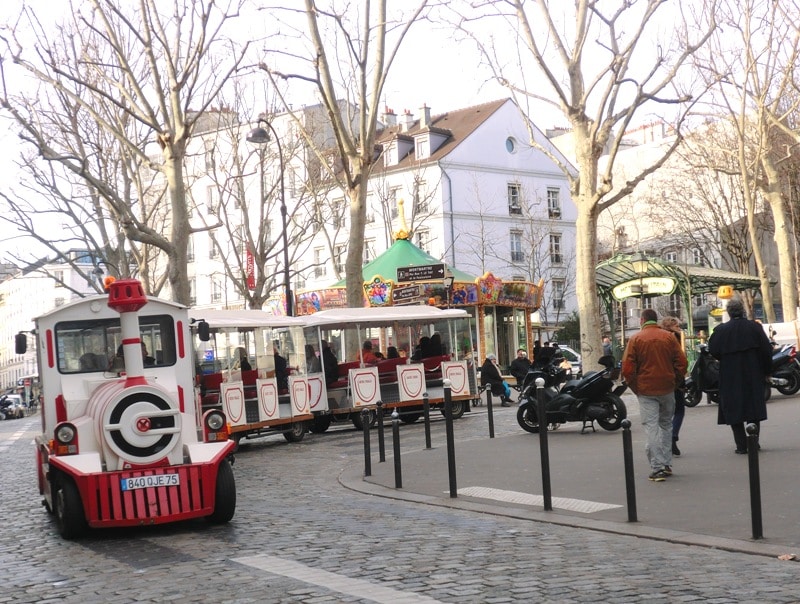
Le Petit train Montmartrain
Address: 1 Parv. du Sacré-Coeur, 75018 Paris:
Map: Parvis du Sacré-Coeur, 75018, Paris
Phone number: +33 6 85 21 95 23
Times: Departure at 10am or 11am depending on the season. The departure is on the Parvis du Sacré-Coeur.
Between Pigalle and the Sacré-Coeur, you will walk through places full of history: from the Place du Tertre to the Lapin Agile cabaret or from Aristide Bruant’s house to Dalida’s.
This pleasant train trip will make you discover in a new way these streets that were once walked by Picasso, Utrillo or Modigliani.
Visit of the Montmartre district in 30 minutes. During the journey, you will have the opportunity to see :
- L’église Saint-Pierre
- Le Moulin Rouge
- Le cimetière de Montmartre
- La station Pigalle
- La vigne de Montmartre
- Le cabaret “Au Lapin Agile”
Price: 4€ for children and 6€ for adults. To enjoy the train, From November 17, 2021, come and witness the first ascent of the Butte Montmartre by electric train.
- Payments by check or cash directly on site at 1 Parvis du Sacré-Coeur.
- For online payments, you will receive a digital ticket recapitulating your order on your e-mail. adult 7 € child (3 years old ,=) 4 €
- If you do not receive your digital ticket, simply show a proof of order before you get on the train.
Le Petit train de Montmartre
Address: 177 Avenue Charles de Gaulle, 92200 Neuilly-sur-Seine
Tel: 0142622400
contact@promotrain.fr
The “Petit Train de Montmartre” offers a musical tour in 2 languages (French – English), in the heart of the Montmartre hill with a stop at Place du Tertre and a departure in front of the Moulin Rouge.
The tour is divided into two parts (one ticket) that can be done at two different times of the day:
- Place Blanche (departure at the bottom of the Butte, near the Moulin Rouge – metro Blanche line 2) to Place du Tertre (duration of the trip: 15 minutes)
- Place du Tertre to the top of the Butte Montmartre (2nd point of departure) and back to Place Blanche (duration of the trip: 30 minutes)
The circuit: Place Blanche / Moulin Rouge / Basilique du Sacré-Coeur / Amphitheatre / Arenas / Saint-Pierre Church / Place du Tertre / Espace Dalí / Montmartre Museum / The Nimble Rabbit / Saint-Vincent Cemetery / Place Constantin Pecqueur / La Halle and the Saint-Pierre market / Anvers / Return to Place Blanche.
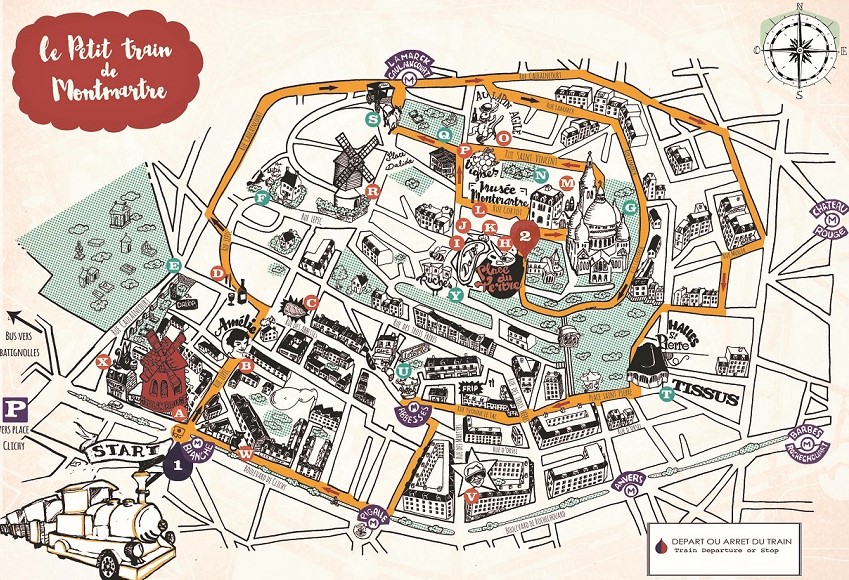
Services
- An ideal formula to discover the Montmartre district with children. The little ones love this visit on board a little train.
- The visit is commented in French and English
- 2 places of departure: Place Blanche (Metro Blanche line 2, at the bottom of the hill) and Place du Tertre (at the top of the hill, near the Sacré Coeur). Departure point of your choice.
- Tip: do the tour in 2 times with unlimited stop at the intermediate stop to visit Montmartre. You can start the tour at the departure point of your choice, stay as long as you want and take the little train of Montmartre in the other direction for the return trip later in the day.
Opening hours :
Visiting hours: every day from 10 am to 6 pm. Nocturne in summer until midnight.
December to April: varies according to dates and school vacations.
Price :
- Adult (over 12 years old): 7 €.
- Children (2 to 12 years old): 4 €.
The RATP bus, line n° 40 (Mairie du 18e – Jules Joffrin⥋Le Peletier) or how to climb the Butte-Montmartre without effort
The RATP line 40 is circular and has no end: the starting point is however the Pelletier Station located at the bottom of the Butte, on the south side. The Bus 40 returns to its starting point after a 4 km ride that takes it to the other side of the Butte, on the north side, after 35 intermediate stops and in 25 to 35 minutes. The furthest north stop is Mairie du 18e – Jules Joffrin
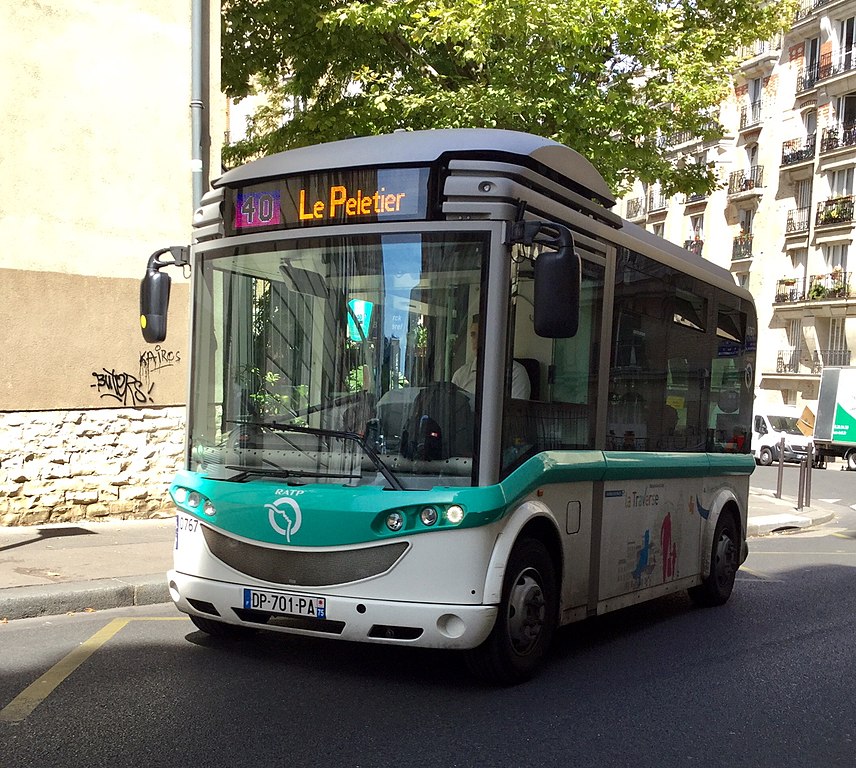
But the outbound route overlaps with the return route, which adds to the confusion and does not facilitate the understanding of the route in its middle part. You will find below the map of the line 40, the stops and the connections with the metro or other buses.

Line 40 operates Monday through Saturday from 7:30 a.m. (the time at which the line departs) to approximately 1:10 a.m. and on Sundays and holidays from 7:20 a.m. Its frequency is :
- A bus every 10 to 30 minutes on weekdays (10 to 15 minutes during the day)
- A bus every 11 to 25 minutes on Saturdays
- One bus every 12 to 25 minutes on Sunday
| Arrêts du bus ligne 40 – Bus stop line 40 | Correspondances – Correspondences |
|---|---|
| Le Peletier (départ et retour de ligne) | Métro 7 Bus 45 |
| Carrefour de Châteaudun | Bus 26 – Bus 32 – Bus 43 – Bus 45 – Bus 74 |
| Saint-Georges | Métro 12 Bus 74 |
| Gustave Toudouze | |
| Navarin | |
| Rochechouart – Martyrs | Bus 30 – Bus 54 |
| Martyrs | Bus 30 – Bus 54 |
| Orsel | |
| Abbesses | Métro 12 |
| Durantin – Burq | |
| Tholozé | |
| Tourlaque | Bus 80 |
| 88, rue Lepic | |
| Moulin de la Galette | |
| Place du Tertre – Norvins | |
| Les Vignes | |
| Lamarck – Caulaincourt | Métro 12 Bus 80 |
| Custine – Mont-Cenis | Bus 80 |
| Mairie du 18e – Jules Joffrin | Métro 12 Bus 31 – Bus 60 – Bus 80 – Bus 85 |
| Marcadet | Bus 80 – Bus 85 |
| Custine – Ramey | Bus 80 |
| Custine – Mont-Cenis | Bus 80 |
| Lamarck – Caulaincourt | Métro 12 Bus 80 |
| Lamarck – Mont-Cenis | |
| Lamarck – Becquerel | |
| Chevalier de la Barre | |
| Utrillo | |
| Funiculaire | Funiculaire Gare Haute |
| Place du Tertre – Norvins | |
| Mont-Cenis – Cortot | |
| Saules – Cortot | |
| Abreuvoir – Girardon | |
| Moulin de la Galette | |
| Gabrielle | |
| Drevet | |
| Chappe | |
| Yvonne Le Tac | |
| Abbesses | Métro 12 |
| Pigalle | Métro 2 – Métro 12 Bus 30 – Bus 54 |
| Navarin | |
| Saint-Georges | Métro 12 Bus 74 |
| Saint-Georges – Châteaudun | Bus 26 – Bus 32 – Bus 43 – Bus 74 |
| Le Peletier | Métro 7 Bus 45 |
Connections between funicular, RATP bus n° 40 and Metro line 2 and 12
There is a direct connection with the bus line 40, the only one to circulate on the Montmartre Hillock, which has a stop on rue du Cardinal-Dubois and offers a connection in front of the upper funicular station.
Two metro stations are also located within walking distance from the lower funicular station: Anvers, on line 2, about two hundred meters to the south, and Abbesses, on line 12, approximately three hundred and fifty meters to the west.
